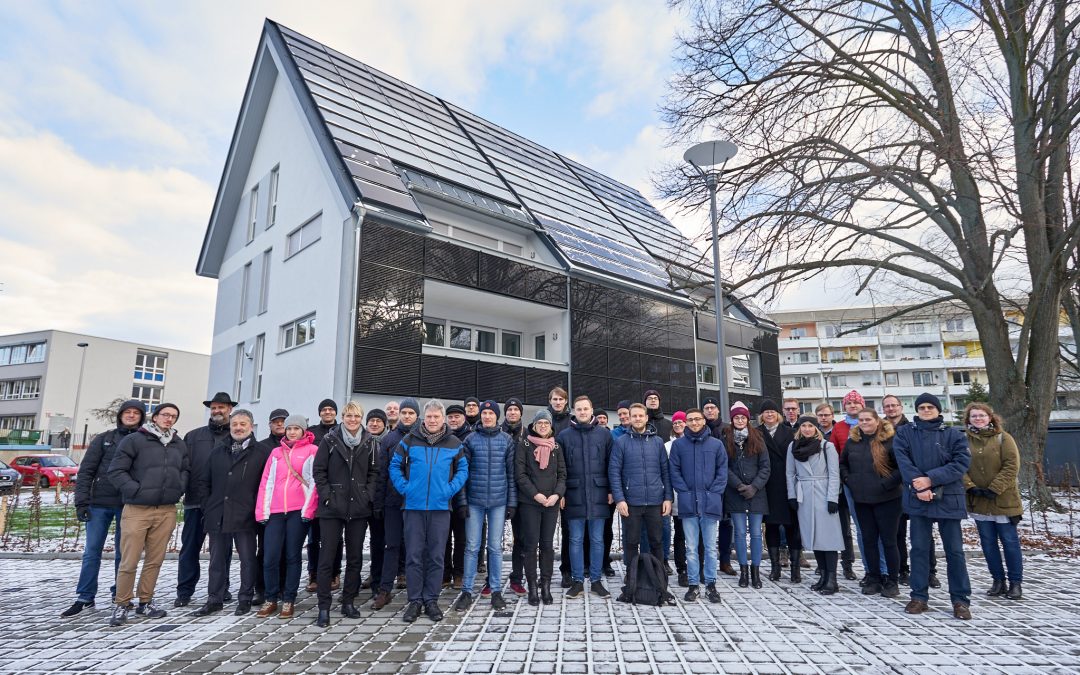The outside temperatures are dropping – a good opportunity for the LowTEMP partners to visit German pilot projects for sustainable heat supply
The “LowTEMP” project, funded by the Interreg Baltic Sea Region Programme for the sustainable expansion of district heating supply, organised a study trip for project partners and interested stakeholders from the partner countries for the third time in mid-January. After the partners were invited on site visits to Denmark and Sweden last year, this time the agenda included visits and presentations on exemplary sustainable district heating supply projects in Berlin and Brandenburg. aconium, which is responsible for project, communication and financial management in the LowTEMP project, organised the two-day event together with its partners from the Brandenburg University of Technology Cottbus and the Hamburg Centre for Energy, Building, Architecture and the Environment (ZEBAU GmbH).
Almost 40 participants from all eight LowTEMP partner countries met at the start of the event in Berlin Adlershof, Germany’s largest science and technology park. An integrated energy concept is also being implemented here with the aim of reducing primary energy consumption in the district by at least 30 percent. The low-temperature network for the newly built “Wohnen am Campus” residential area is particularly noteworthy. Here, a low-energy residential district is being supplied with district heating from a combined heat and power plant (CHP). Compared to decentralied solutions (gas boiler or CHP), up to 75 percent of primary energy can be saved and compared to conventional district heating, a saving of around 20 percent of primary energy can be achieved. In addition to presentations and a visit to the residential area, the partners had the opportunity to visit the power-to-heat plant in the BTB GmbH combined heat and power plant.
The partners then traveled to Cottbus, where they were first welcomed at the “Max-Steenbeck-Gymnasium” energy-saving school. This is one of the first former prefabricated school buildings to be renovated according to passive house criteria. A special feature of the heat supply is the use of a 40 m² solar collector field to generate solar heat for hot water production in the gymnasium. Solar heat that is not used directly or has a temperature level that is too low for hot water production is stored.
At around 57 percent, the heating market is the largest final energy consumption sector in Germany. The heating and hot water supply of private households accounts for 66 percent of this. However, energy-efficient district heating sales in Germany are stagnating at around 120 billion kWh per year. Fourth-generation district heating systems would be an important means of achieving the EU climate targets: 20 percent more energy efficiency by 2020 (compared to 1990). EU member state Germany, for example, wants to reduce energy consumption in its building stock by two thirds by 2030 and be climate-neutral by 2050.
Source: BDEW, BMU
On the second day of the study trip, the project partners visited Cottbusser Wohnungsbaugenossenschaft eG Wohnen. A special attraction was the presentation and visit to the energy self-sufficient solar houses that have just been completed. The apartment buildings supply themselves with heat and electricity from the sun. The basic energy concept of the buildings prompted the project partners to discuss the advantages and disadvantages of conventional district heating compared to a self-sufficient, decentralised heat supply in the building.
The last item on the programme of the study trip was a visit to Berlin’s largest solar thermal plant, which was built by Vattenfall in the Köpenick district last year. The combined heat and power plant supplies around 10,000 households with district heating, which is now far more climate-neutral thanks to energy generation from the sun. Edgar Scheider, the engineer responsible at Vattenfall, sees the use of the solar thermal plant as an important contribution by the company to the energy transition. In addition to phasing out lignite and hard coal in the coming decade, the expansion of the district heating network is also part of Vattenfall’s catalog of measures. Berlin already has the largest district heating network in Western Europe. Vattenfall, the capital’s largest energy supplier, is currently working with the state of Berlin on a feasibility study on phasing out coal, which should be available in the first half of 2019. The empirical values from the new solar thermal plant are to be incorporated into this.
The study trip provided the participants with important knowledge about sustainable heat supply systems. Over the next two years of the project, this know-how and the increased awareness of the need to introduce future-oriented district heating systems should help to implement energy-efficient, sustainable and innovative heat supply projects throughout the Baltic Sea region.
Further information on the project “LowTEMP – Low Temperature District Heating for the Baltic Sea Region”.


